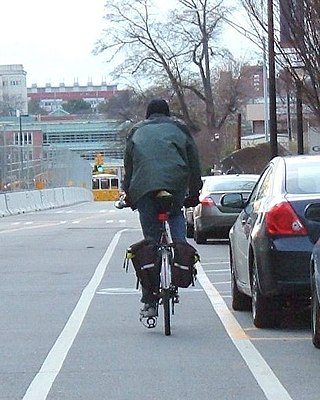
High-visibility clothing, sometimes shortened to hi vis or hi viz, is any clothing worn that is highly luminescent in its natural matt property or a color that is easily discernible from any background. It is most commonly worn on the torso and arm area of the body. Health and safety regulations often require the use of high visibility clothing as it is a form of personal protective equipment. Many colors of high visibility vests are available, with yellow and orange being the most common examples. Colors other than yellow or orange may not provide adequate luminescence for conformity to standards such as ISO 20471.

Automotive safety is the study and practice of automotive design, construction, equipment and regulation to minimize the occurrence and consequences of traffic collisions involving motor vehicles. Road traffic safety more broadly includes roadway design.

Road traffic safety refers to the methods and measures used to prevent road users from being killed or seriously injured. Typical road users include pedestrians, cyclists, motorists, vehicle passengers, and passengers of on-road public transport.

Utility cycling encompasses any cycling done simply as a means of transport rather than as a sport or leisure activity. It is the original and most common type of cycling in the world. Cycling mobility is one of the various types of private transport and a major part of individual mobility.

The European New Car Assessment Programme is a European voluntary car safety performance assessment programme based in Leuven, Belgium. Formed in 1996, the first results were released in February 1997. It was originally started by the Transport Research Laboratory for the UK Department for Transport but later backed by several European governments, as well as by the European Union (EU). Their slogan is "For Safer Cars".
Traffic psychology is a discipline of psychology that studies the relationship between psychological processes and the behavior of road users. In general, traffic psychology aims to apply theoretical aspects of psychology in order to improve traffic mobility by helping to develop and apply crash countermeasures, as well as by guiding desired behaviors through education and the motivation of road users.

Risk compensation is a theory which suggests that people typically adjust their behavior in response to perceived levels of risk, becoming more careful where they sense greater risk and less careful if they feel more protected. Although usually small in comparison to the fundamental benefits of safety interventions, it may result in a lower net benefit than expected or even higher risks.

A rollover or overturn is a type of vehicle crash in which a vehicle tips over onto its side or roof. Rollovers have a higher fatality rate than other types of vehicle collisions.

The National Traffic and Motor Vehicle Safety Act was enacted in the United States in 1966 to empower the federal government to set and administer new safety standards for motor vehicles and road traffic safety. The Act was the first mandatory federal safety standards for motor vehicles. The Act created the National Highway Safety Bureau. The Act was one of a number of initiatives by the government in response to increasing number of cars and associated fatalities and injuries on the road following a period when the number of people killed on the road had increased 6-fold and the number of vehicles was up 11-fold since 1925. The reduction of the rate of death attributable to motor-vehicle crashes in the United States represents the successful public health response to a great technologic advance of the 20th century—the motorization of the United States.

Dooring is the act of opening a motor vehicle door into the path of another road user. Dooring can happen when a driver has parked or stopped to exit their vehicle, or when passengers egress from cars, taxis and rideshares into the path of a cyclist in an adjacent travel lane. The width of the door zone in which this can happen varies, depending upon the model of car one is passing. The zone can be almost zero for a vehicle with sliding or gull-wing doors or much larger for a truck. In many cities across the globe, doorings are among the most common and injurious bike-vehicle incidents. Any passing vehicle may also strike and damage a negligently opened or left open door, or injure or kill the exiting motorist or passenger.

Motorcycle safety is the study of the risks and dangers of motorcycling, and the approaches to mitigate that risk, focusing on motorcycle design, road design and traffic rules, rider training, and the cultural attitudes of motorcyclists and other road users.

Bicycle safety is the use of road traffic safety practices to reduce risk associated with cycling. Risk can be defined as the number of incidents occurring for a given amount of cycling. Some of this subject matter is hotly debated: for example, which types of cycling environment or cycling infrastructure is safest for cyclists. The merits of obeying the traffic laws and using bicycle lighting at night are less controversial. Wearing a bicycle helmet may reduce the chance of head injury in the event of a crash.

An equestrian helmet is a form of protective headgear worn when riding horses. This type of helmet is specially designed to protect the rider's head in the event of falls from a horse, especially from striking a hard object while falling or being accidentally struck in the head by a horse's hoof.

Transportation safety in the United States encompasses safety of transportation in the United States, including automobile crashes, airplane crashes, rail crashes, and other mass transit incidents, although the most fatalities are generated by road incidents annually killing 32,479 people in 2011 to over 42,000 people in 2022. The number of deaths per passenger-mile on commercial airlines in the United States between 2000 and 2010 was about 0.2 deaths per 10 billion passenger-miles. For driving, the rate was 150 per 10 billion vehicle-miles: 750 times higher per mile than for flying in a commercial airplane.

A traffic collision, also known as a motor vehicle collision, or car crash, occurs when a vehicle collides with another vehicle, pedestrian, animal, road debris, or other moving or stationary obstruction, such as a tree, pole or building. Traffic collisions often result in injury, disability, death, and property damage as well as financial costs to both society and the individuals involved. Road transport is statistically the most dangerous situation people deal with on a daily basis, but casualty figures from such incidents attract less media attention than other, less frequent types of tragedy. The commonly used term car accident is increasingly falling out of favor with many government departments and organizations, with the Associated Press style guide recommending caution before using the term. Some collisions are intentional vehicle-ramming attacks, staged crashes, vehicular homicide or vehicular suicide.

A roadway departure is a type of incident that occurs when a vehicle leaves the roadway. Such incidents can lead to a single-vehicle collision.
Worker road safety refers to the economic, societal, and legal ramifications of protecting workers from automobile-related injury, disability, and death. Road traffic crashes are a leading cause of occupational fatalities throughout the world, especially in developing countries. In addition to the suffering of the workers and their families, businesses and society also bear direct and indirect costs. These include increased insurance premiums, the threat of litigation, loss of an employee, and destruction of property.
The Decade of Action for Road Safety 2011–2020 was officially proclaimed by the United Nations General Assembly in March 2010. Its goal is to stabilize and reduce the forecast level of road traffic deaths around the world. It is estimated that 5 million lives could be saved on the world's roads during the decade.

People who are driving as part of their work duties are an important road user category. First, workers themselves are at risk of road traffic injury. Contributing factors include fatigue and long work hours, delivery pressures, distractions from mobile phones and other devices, lack of training to operate the assigned vehicle, vehicle defects, use of prescription and non-prescription medications, medical conditions, and poor journey planning. Death, disability, or injury of a family wage earner due to road traffic injury, in addition to causing emotional pain and suffering, creates economic hardship for the injured worker and family members that may persist well beyond the event itself.

Road safety in Europe encompasses transportation safety among road users in Europe, including automobile accidents, pedestrian or cycling accidents, motor-coach accidents, and other incidents occurring within the European Union or within the European region of the World Health Organization. Road traffic safety refers to the methods and measures used to prevent road users from being killed or seriously injured.
















